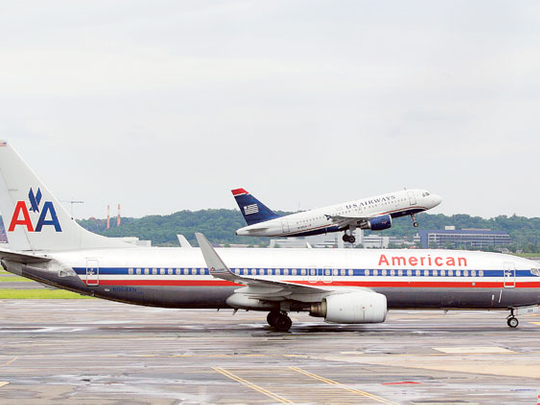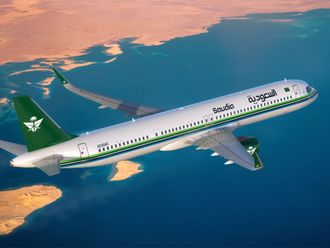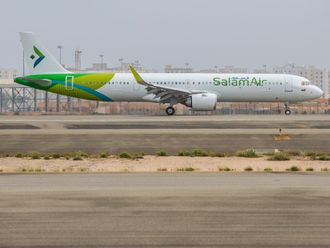
NEW YORK: American Airlines is weighing various options for its future, but most analysts say the nation's No 3 airline only has one viable choice: combine with No 5 US Airways.
American could leave bankruptcy protection as an independent airline. Or join forces with a much smaller airline such as JetBlue or Frontier. There has been talk of a tie-up with United or Delta, the nation's two biggest airlines, or possibly a large infusion of cash from a foreign airline or a private equity firm.
Some of those scenarios might be wishful thinking, while others will at least be vetted by management. Tom Horton, CEO of American's parent AMR Corp, said on Tuesday that he is now evaluating “a range of strategic options, including potential mergers.” Here are some of the possibilities:
- US AIRWAYS MERGER
If you listen to Wall Street, this is the only outcome that makes sense. Analysts say the airlines have somewhat complementary route networks and both are too small to thrive on their own. Investors agree - the price of US Airways Group Inc stock has more than tripled since November 28, when American filed for bankruptcy.
US Airways CEO Doug Parker has aggressively pushed for a combination. He won the support of American's three largest unions — their leaders even posed for photos with him at the company's annual meeting. That's where he gave a slide presentation showing that the combined airline would have the largest market share east of the Rockies.
In many ways, Parker is right: Both airlines have to merge.
In the last five years, Delta combined with Northwest and United joined with Continental to create two behemoths that control nearly 60 per cent of the market. American, which was once the world's largest carrier, has just under 20 per cent of the market and US Airways has another 10 per cent. Teaming up, they would be on par with Delta and United.
“They just aren't going to be competitive without merging together,” said Robert Herbst, an independent airline analyst.
American would gain feeder flights from smaller cities to its hubs as well as US Airways' lucrative shuttle service between New York, Boston and Washington D.C. US Airways would gain higher-profit international routes.
Still, there would be headaches. Seven years ago, America West bought US Airways out of bankruptcy, taking its name. The two airlines still have not merged staffs, with former America West pilots flying only with other former America West pilots. Adding American to the mix will complicate matters but could also help. The larger American unions would have enough voting power to outweigh any of the disagreements between the two US Airways labour groups.
American still has the exclusive right in the bankruptcy process to work out a restructuring plan acceptable to the court and its creditors. If it doesn't find an acceptable merger partner, it could go it alone.
- INDEPENDENT AMERICAN
Before this week, American's management said it wanted to remain independent, vowing to emerge from bankruptcy protection as a more competitive, financially sound airline.
Indeed, American is using the bankruptcy process to slash employee wages. It also has an ambitious plan to replace its planes with newer, more fuel-efficient models.
But it still doesn't have the size or route network to compete with other airlines. Domestically, it is often undercut by low-cost airlines like Spirit Airlines Inc and Virgin America. Internationally, it faces fierce competition from Delta and United as well as foreign airlines like Air France and Dubai's Emirates. In order to survive independently, American would have to beef up its presence on the East Coast and West Coast. That would mean expanding at a time when the rest of the industry has been cutting flights to deal with decreasing demand.
- MERGING WITH DELTA OR UNITED
A deal with Delta Air Lines or United, part of United Continental Holdings Inc. might make financial sense. But any such combination would control such a large share of flights that antitrust regulators would likely vote thumbs down.
The Department of Transportation has been trying to let smaller airlines like Southwest Airlines, JetBlue Airways Corp. and Virgin America compete in some markets such as New York and Washington, D.C. The Department of Justice did allow Southwest and AirTran to merge. But to put that in perspective, a merged American-United would be more than three times as large as the combined Southwest-AirTran.
“There's no way that the DOJ and the DOT are going to let Delta or United in any way, shape or form to get any part of American Airlines,” said Herbst.
- JETBLUE, VIRGIN AMERICA, FRONTIER OR ALASKA
Merging with a smaller airline isn't practical. JetBlue, the largest of this group, would add only 170 planes to American's 900-plane fleet. JetBlue and Alaska have great feeder networks on the East and West Coast, respectively, but American already has partnerships with both carriers that bring passengers to its hubs in cities like New York and Los Angeles.
JetBlue has been expanding in the Caribbean and cities in the Northeast - many locations abandoned by American. JetBlue's lower labour costs make this possible, said Ray Neidl, an airline specialist with the Maxim Group.
“A lot of markets JetBlue is expanding into, American can't make money in,” Neidl said.
Frontier would give American a foothold in Denver. But United and Southwest are already there, and the city isn't large enough to support three major airlines. Airlines want to dominate their hub cities, not fight for travellers there.
Virgin America is loved by its passengers but has struggled to post a profit and has large debt - not exactly what a company coming out of bankruptcy wants.
- FOREIGN OWNERSHIP
US law prohibits foreign entities from having a majority stake in airlines here. A partial ownership could give American some cash but would do little to improve its route structure. The airline already has antitrust immunity to collaborate with British Airways, Iberia, Japan Airlines and Qantas on routes and pricing.
The same goes for a private equity investment - it would give American capital to make improvements but wouldn't solve the weakness in its route network.
AP











